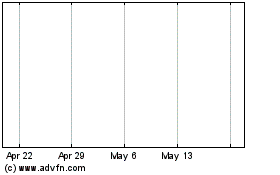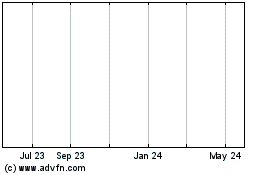A.G. Edwards Nest Egg Score Increases to 645--Most Favorable Wealth-Building Environment in 12 Months
March 20 2007 - 5:00AM
Business Wire
At 645, the March 2007 Nest Egg Score�released today by A.G.
Edwards (NYSE:AGE)�increased eight points since December 2006 and
shows that opportunities for building personal wealth are the best
since this time last year. Despite this positive wealth-building
environment, the A.G. Edwards Nest Egg Score Survey found that 31
percent of U.S. adults have not done anything within the past 12
months toward building their personal savings, even though 67
percent of adults believe personal choices have a greater impact on
their ability to build personal savings. One-third of adults (33
percent) believe external factors such as their economy have a
greater influence on their ability to build personal savings. �The
Nest Egg Score�s improvement this quarter is partially driven by
continued low unemployment and moderate inflation due primarily to
declining energy prices," said Gary Thayer, A.G. Edwards� chief
economist. �While these economic factors contribute to an improved
environment for building savings, it is also important for people
to understand that personal choices are just as important�if not
more so. It is vital for Americans to take�advantage of this
favorable economic climate and take positive steps toward boosting
their savings�even if it is as simple as putting aside�a portion of
their tax refund or increasing participation in a retirement plan.�
The A.G. Edwards Nest Egg Score is a proprietary analysis of 12
factors that influence the ability of adults to build wealth, and
it includes such government measures as the savings rate,
wealth-to-income ratio, the cost of living and the home equity
rate, along with proprietary research that evaluates Americans�
saving and investing behaviors. Quarterly data for each factor is
evaluated and scored on the following scale: 450 to 549�poor; 550
to 649�fair; 650 to 749�good; and 750 to 850�excellent. According
to data used to calculate the March 2007 A.G. Edwards Nest Egg
Score, several factors contributed to the increase: The
wealth-to-income ratio rose to its highest level during a five-year
comparison period. A cost of living decline also helped boost the
Nest Egg Score. The unemployment rate remained at a five-year low.
To gain insight into the savings and investing behaviors of
Americans, A.G. Edwards commissioned the March 2007 Nest Egg Score
Survey, conducted by Harris Interactive�. The survey was conducted
during the week of February 12, 2007 among a sample of 2,405 U.S.
adults age 18 and over. The $75,000 Question The A.G. Edwards Nest
Egg Score Survey indicated a relationship between household income
and a likelihood to actively take steps toward building personal
savings. Seven out of 10 adults with a household income of $75,000
a year or more (70 percent), reported having taken steps to build
their personal savings within the past 12 months. They were more
likely to have opened a savings and/or investment account, as well
as more likely to have met with a financial advisor and/or decided
against making a discretionary purchase than their counterparts
earning less than $35,000 a year. The following table offers a
comparison of saving, investing and spending behaviors across four
different annual household income levels: Saving and Investing
Action (within the past 12 months) � $75,000+ annual household
income � $50,000-$74,999 annual household income � $35,000-$49,999
annual household income � Less than $35,000 annual household income
Took any step to build personal savings � 70 percent � 68 percent �
62 percent � 51 percent Decided against making a discretionary
purchase � 28 percent � 27 percent � 23 percent � 14 percent Opened
a savings or investment account � 19 percent � 12 percent � 16
percent � 11 percent Met with a financial advisor � 14 percent � 11
percent � 8 percent � 4 percent (a) Percentages may not total 100
percent due to weighting, rounding, and/or the acceptance of
multiple responses. �Taking an active role in securing your
financial future is imperative,� said A.G. Edwards Financial
Planning Specialist Sophie Beckmann. �While opening a savings
account and reducing debt are good first steps, investors should
also consider boosting contributions to their retirement plan and
meeting with a financial advisor.� Boomers Perceived As Best At
Saving The A.G. Edwards Nest Egg Score Survey also examined
generational attitudes regarding influences on people�s ability to
increase personal savings. For the purpose of the study,
generations were defined as �Mature Adults� born before 1946, �Baby
Boomers� born between 1946 and 1964, �Gen X� born between 1965 and
1978 and �Gen Y� born in 1979 and after. When asked which
generation of adults is best able to build personal savings, 26
percent of all adults said Baby Boomers, followed by 19 percent who
selected Mature Adults. When asked why they think Baby Boomers are
best able to build personal savings, here�s what all U.S. adults
said: 42 percent attributed Boomers� saving success to higher
salaries. 31 percent said Boomers are more educated about personal
finance management. 30 percent said Boomers have more retirement
support through employer- and government-sponsored programs. 29
percent identified Boomers as more fiscally conservative than other
generations. 24 percent said Boomers have access to a wider variety
of savings and investment vehicles. Saving At Every Stage Of Life
The March Nest Egg Score Survey also suggests that good savings and
investing habits seem to kick in when someone lands that
all-important first job as an adult. In fact, of adults who have
personal savings, more than one-third (35 percent) cited
employment-related events�such as their first job (20 percent) or a
change in employment such as a promotion or new job (16 percent)�as
the primary factors that prompted their decision to start building
savings. Other milestones noted: 24 percent of adults were inspired
to start building personal savings due to marriage, separation,
divorce or getting engaged. 23 percent of adults were encouraged by
their parents to start saving, but only 57 percent of all adults
reported having any type of personal savings. �People are at a
significant advantage the earlier they start building their nest
eggs,� said Beckmann. �As our research suggests, some older adults
may have waited until they secured their first job or got married
before they started thinking about building their personal savings,
but if these same adults encourage kids to start saving early,
children will be in a much better position in the long run.�
Beckmann points out that if a 25-year-old invested $50 per month
into a tax-deferred account, by the time he or she turns 65, the
account would be worth more than $175,000, assuming an 8 percent
annual rate of return. If they started saving the same amount at
age 15, assuming the same 8 percent rate of return, the account
would be worth $400,000 at 65.(b) (b) Example is for illustrative
purposes only and does not reflect the performance of any specific
investment. What�s Your Score? Visit Nesteggscore.com To help
people determine their personal Nest Egg Score, A.G. Edwards offers
the Nest Egg Score Estimator. The Nest Egg Score Estimator asks a
variety of questions including length of employment at current job,
annual household income, investment preferences, risk tolerance,
home equity and discretionary spending habits. It also takes into
consideration age, marital status and where someone lives. To find
out how your savings and investing habits rate in relation to the
rest of the country, please visit nesteggscore.com. About the Nest
Egg Score The A.G. Edwards Nest Egg Score is a single, quarterly,
three-digit numerical rating that represents a measure of the
relative strength or weakness of Americans� wealth-building
performance, similar to the scoring systems used to evaluate
creditworthiness. A high Nest Egg Score indicates that households
are having more success in building their nest eggs or that
economic conditions are favorable for saving and investing.
Conversely, a low score means that households are not taking
advantage of opportunities to build their nest eggs or that
economic conditions are not conducive to wealth accumulation. To
create the Nest Egg Score, A.G. Edwards takes into account 12
statistical factors gathered from federal government data and
proprietary research conducted for A.G. Edwards by Harris
Interactive� that pertain to building wealth. Quarterly data for
each factor is evaluated and scored on the following scale: 450 to
549�poor; 550 to 649�fair; 650 to 749�good; and 750 to
850�excellent. The 12 individual factors are then combined and
weighted to determine the A.G. Edwards Nest Egg Score. For further
information on the A.G. Edwards Nest Egg Score, go to
nesteggscore.com. Nest Egg Score Survey Methodology The five
quarterly Nest Egg Score surveys were conducted online by Harris
Interactive� on behalf of A.G. Edwards among a nationwide sample of
U.S. adults aged 18 and over within the United States as follows:
between Feb. 13 and Feb. 15, 2007 among 2,405 adults; between Nov.
17 and Nov. 21, 2006 among 2,323 adults; between Aug. 23 and Aug.
25, 2006 among 2,295 adults; between May 23 and May 25, 2006 among
2,197 adults; and between March 14 and March 16, 2006 among 2,182
adults. Figures for region, age within gender, education, household
income and race/ethnicity were weighted where necessary to bring
them into line with their actual proportions in the population.
Propensity score weighting was also used to adjust for respondents�
propensity to be online. With a pure probability sample of these
sizes one could say with a 95 percent probability that the overall
results have a sampling error of +/- 3 percentage points. Sampling
error for data based on sub-samples may be higher and may vary.
However that does not take other sources of error into account.
This online survey is not based on a probability sample and
therefore no theoretical sampling error can be calculated. Harris
Interactive� is responsible for fielding the online surveys on
behalf of A.G. Edwards. A.G. Edwards is responsible for the
compilation of data from other sources and for computing the Nest
Egg Score and the results reported. About A.G. Edwards & Sons,
Inc. Drawn to the firm�s client-first philosophy, individuals and
businesses have turned to A.G. Edwards for sound advice and access
to a wide array of investment products and services that can help
them meet their financial goals and objectives. Founded in 1887,
A.G. Edwards and its affiliates employ nearly 6,700 financial
consultants in more than 740 offices nationwide and two European
locations in London and Geneva. More information can be found on
agedwards.com. How A.G. Edwards Does Business A.G. Edwards
generally acts as a broker-dealer but may act as an investment
advisor on designated accounts, and the firm�s obligations will
vary with the role it plays. When working with clients, the firm
generally acts as a broker-dealer unless specifically indicated in
writing. To better understand the differences between brokerage and
advisory services, please consult �Important Information About Your
Relationship With A.G. Edwards� on agedwards.com/disclosures. About
Harris Interactive� Harris Interactive� is the 12th largest and
fastest-growing market research firm in the world. The company
provides innovative research, insights and strategic advice to help
its clients make more confident decisions which lead to measurable
and enduring improvements in performance. Harris Interactive� is
widely known for The Harris Poll, one of the longest running,
independent opinion polls and for pioneering online market research
methods. The company has built what it believes to be the world�s
largest panel of survey respondents, the Harris Poll Online. Harris
Interactive serves clients worldwide through its United States,
Europe and Asia offices, its wholly-owned subsidiary Novatris in
France and through a global network of independent market research
firms. The service bureau, HISB, provides its market research
industry clients with mixed-mode data collection, panel development
services as well as syndicated and tracking research consultation.
More information about Harris Interactive� may be obtained at
harrisinteractive.com.
A G Edwards (NYSE:AGE)
Historical Stock Chart
From Apr 2024 to May 2024

A G Edwards (NYSE:AGE)
Historical Stock Chart
From May 2023 to May 2024
